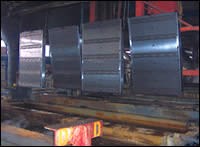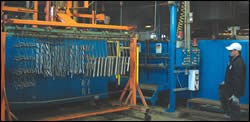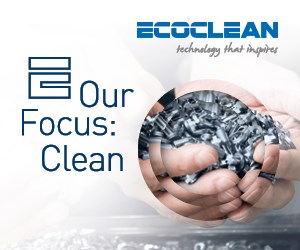Serendipity and Smart Management
This job shop found itself in position to capitalize when two large manufacturers with captive plating operations decided to exit the electroless nickel plating business.
At the end of the last century (sounds like a long time ago, doesn’t it?), Triple Cities Metal Finishing Corporation (TCMF) of Binghamton, NY was like a lot of plating job shops.
The company was operating out of two facilities, both of which were fairly bursting at the seams. “Many job shops tend to put on an addition, then another, then another, so you walk through a maze of rooms,” says Vice President Charles Morgan. “And we were like that. We never had the room to lay out a line properly. It was always, ‘This is what room we have. What can we fit?’ It should have been, ‘This is what we want to have, where are we going to put it?’”
Still, TCMF was doing pretty well. Managers developed focused process areas, with electroless nickel plating operations in one building and other processes, such as black oxide, in another. The company’s EN business, based on a U-shaped line with 200-gal polypropylene tanks, grew substantially.
Right Place, Right Time
In 1999, Xerox Corp. decided to outsource its EN and zinc operations. TCMF agreed to take on the work and the automated lines, which featured four 1,000-gal stainless steel tanks and a correspondingly large ventilation system. “At Xerox, the line was located in an 84-acre, air conditioned building,” Morgan says. “We needed a helicopter to get the blowers off the roof. It was a big project, but it was a nice deal for us.”
TCMF first transitioned the Xerox work to its manual EN line, then began removing the automatic lines. But because the company had no space to fit the large lines, they were temporarily placed in storage. Managers began looking for a larger building that would allow them to consolidate operations and fit the new lines, eventually moving in to an existing 125,000 sq ft facility.
It was about then that another large New York-based corporation, Kodak, approached TCMF. Kodak also wanted to exit the plating business, so TCMF purchased all of Kodak’s plating equipment, including an automatic EN line. “As part of the purchase agreement for the equipment, we agreed to match their internal price structure for the plating,” Morgan explains.
Learning Curve
In the space of a couple of years, TCMF had evolved from running a manual EN line to operating two automated lines. “We went from having little capacity to having a lot of capacity,” Morgan recalls. “But we were learning—we were never an automated company, and there’s a learning curve with automation. The good thing is, once the line is up and running and you work through the learning curve, it doesn’t make a bad part.”
The 2001 dip in the U.S. manufacturing economy forced TCMF to look for other work to fill its new EN capacity. The company slowly built business back up to the point that they keep one of the automatic lines busy pretty much around the clock, five days a week. The other line is ready to take on new work. The combination of having large capacity and running the lines with regularity results in several operating advantages for TCMF.
“We run three shifts, and our goal is to run out of work every day,” Morgan explains. “Now, we don’t really want to hit that goal, but we also don’t want to have a big backlog. People want their parts back, and it’s a lot easier for us to give them their parts before they call looking for them.”
Morgan says more than half the parts are received in the afternoon and shipped back out in the morning. “Another 25% come in in the morning and go out in the afternoon,” he says. “The capacity we have, and the robustness of our line, allows us to give service that a lot of shops can’t.
“All the parts we EN plate are metal, and the majority are machined,” Morgan continues. “On an average day, we run 80,000 lb of steel through our line and we are still only at 50% capacity.”
Many components go into electronics assemblies, but one big customer makes parts for heavy equipment—shafts, pistons and other components. “We do a lot of 0.0008-inch to one-mil thick EN for them,” Morgan explains. “Electronics work tends to be thinner—the Xerox work, for example, is 0.0002 inch minimum thickness.”
Bath Chemistry
The chemistry for TCMF’s EN operations has been supplied by MacDermid Inc. (Waterbury, CT) for more than seven years. “MacDermid has always worked with TCMF to help the company save money, improve productivity and keep up with changing environmental and other regulations,” Morgan says.
The most significant change, about a year ago, was to Niklad LMO chemistry in both “conventional” and ELV, RoHS and WEEE-compliant chemistries. The LMO stands for low-metal operation. TCMF uses nickel metal at three gal/liter, half the metal of a standard commercial bath.
“Nickel prices were starting to go up, and MacDermid approached us with the idea of running the metal at half the previous concentration without affecting plating rate or anything else in the process,” Morgan recalls.
“The bath worked exactly as MacDermid predicted. Our plating rate remained the same and our make-up costs dropped in half,” he continues. “The lower nickel concentration allowed less drag-out and less misting, which equates to using less chemistry, less cleaning and less waste treatment. We keep separate financials for each of our plating departments, and the savings from this new bath more then offset the increased nickel prices.”
According to MacDermid, a standard EN bath with six gal/liter of nickel contains about 120 g/liter of dissolved solids on make-up, depending on the formulation. Each turnover on a standard bath adds about 45–60 g/liter of solids, again depending on the specific bath formula.
A LMO bath, in contrast, has about 75 g/liter of solids at make-up, giving the bath capacity for more reaction by-products. The result is extended bath life—typically, an increase of half to one turnover or a 10–15% increase. Cost savings also result from less downtime, reduced drag-out, lower waste treatment costs and less nickel misting.
Line Operation
The LMO chemistry and 1,000-gal capacity of the tanks in TCMF’s large EN line allows the company to take a unique approach to process management.
“A lot of EN platers might not have an automated process, but they have automated bath analysis,” Morgan says. “We turned those machines off. We’ve got 1,000-gal tanks, and we’re running them pretty much non-stop. The square footage running through them is pretty consistent. So, instead of having automatic controllers that need frequent maintenance and calibration, we focus on making standard additions that make sense.”
A similar common-sense approach applies when deciding whether to continue operating a tank or make up a new one. “Once you get to a certain number of turns, the risk of plating out your tank isn’t worth the reward,” Morgan explains. “If you dump you EN tank at eight turns versus nine, you’re only talking differences of tenths of a cent in terms of mil square foot cost.
“It’s just not worth the risk,” he concludes. “So if, for example, we’re heading into a weekend with a tank that’s at more than seven turns, we’ll dump the bath and passivate the tank over the weekend, because we don’t want to be shut down during the week.”
Related Content
Clean Technology Lasers for Coating Adhesion
Laser cleaning systems remove corrosion, grease, residue and existing coatings from metal surfaces quickly, with less preparation and mess than traditional techniques.
Read MoreConversion Coatings: Phosphate vs. Zirconium
Both phosphate-based and zirconium coatings have their advantages, but zirconium is fast becoming the pretreatment of choice.
Read MorePretreatment of Black Oxide
Having issues achieving a consistent color with the application of black oxide? Start by looking at your pretreatment. Connor Callais of Hubbard-Hall offers advice for troubleshooting your black oxide process.
Read MoreTop Reasons to Switch to a Better Cleaning Fluid
Venesia Hurtubise from MicroCare says switching to the new modern cleaning fluids will have a positive impact on your cleaning process.
Read MoreRead Next
Episode 42: An Interview with Robin Deal, Hubbard-Hall
Hubbard-Hall wastewater treatment specialist Robin Deal discusses the latest trends in wastewater management.
Read MorePowder Coating 4.0: Smarter, Faster, More Efficient and Connected
New tools reduce cost and waste, lower manufacturing footprint of powder coating operations.
Read MoreThe 2024 Ford Mustang: All the Colors Available
Although Chevrolet has announced the end of the Camaro and Dodge is offering “Last Call” editions of the Charger and Challenger, the Ford Mustang is launching to its seventh generation.
Read More




















_KOCH.jpg;maxWidth=300;quality=90)










